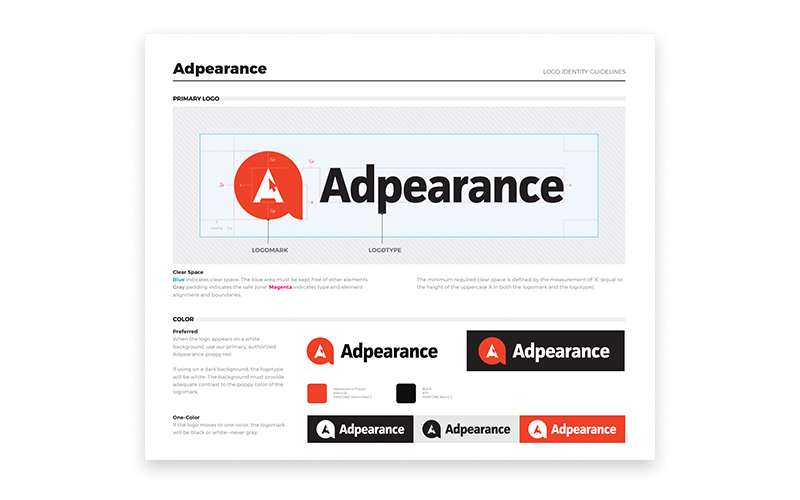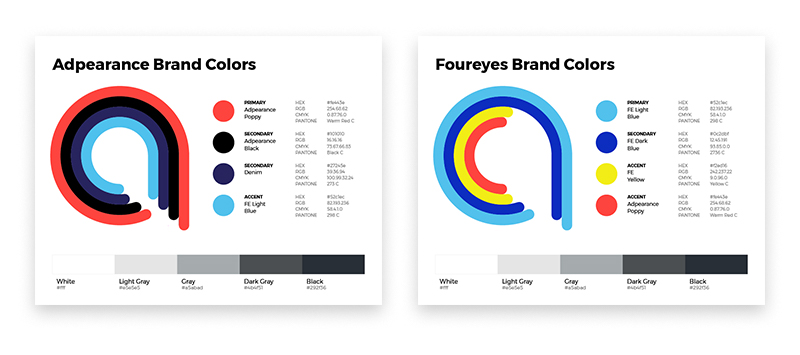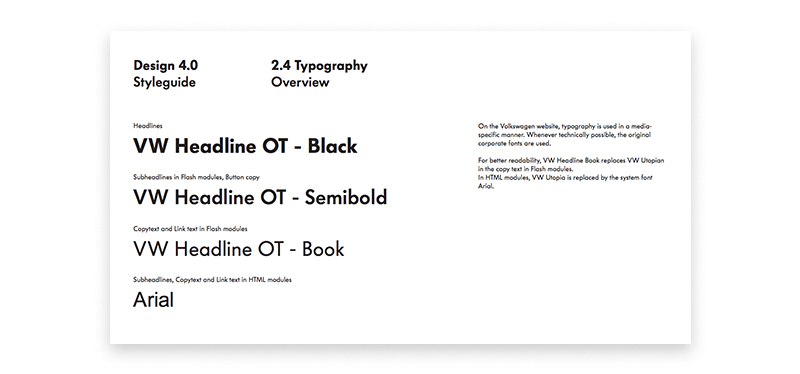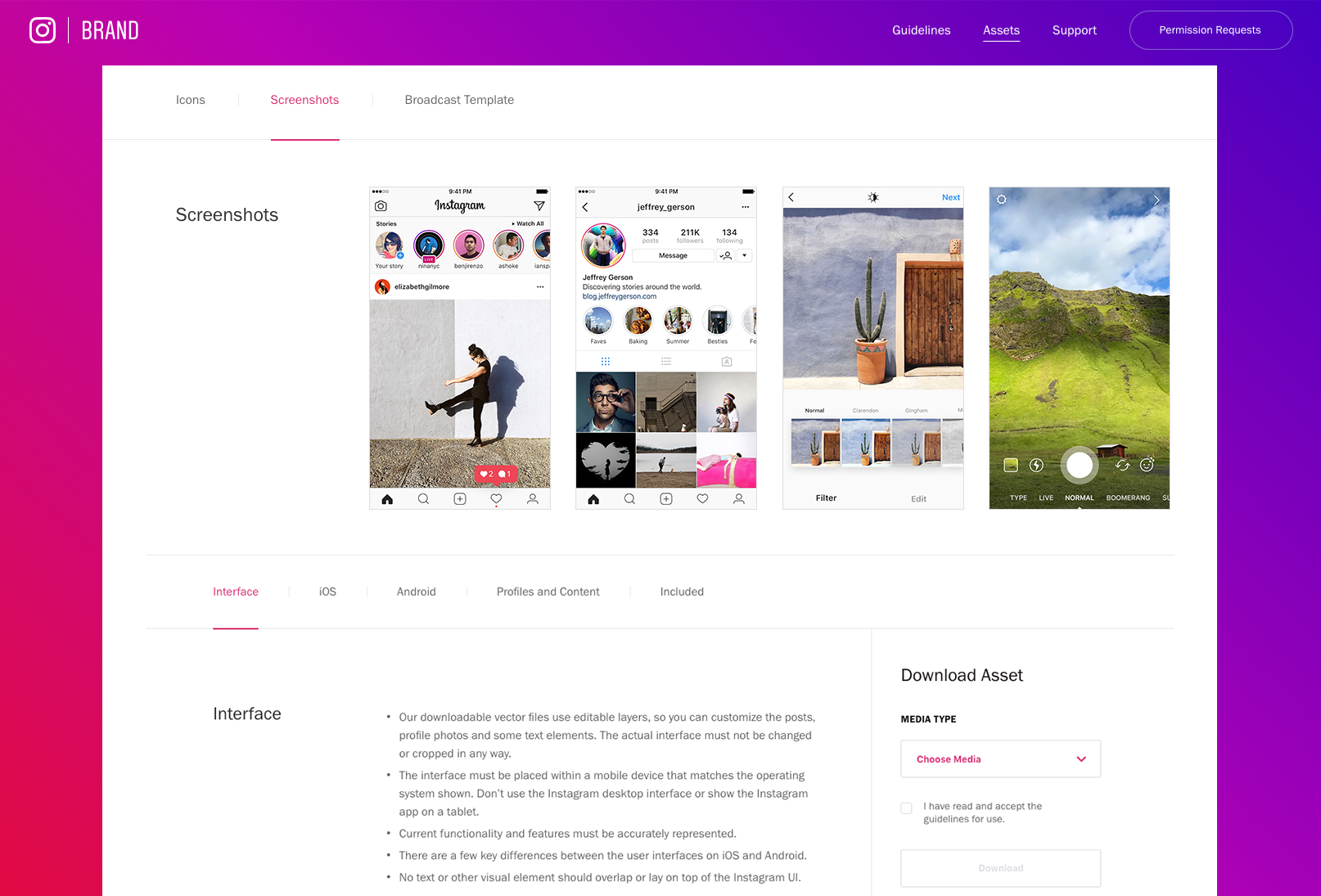How to Make Usable Brand Guidelines
Part of scaling your identity is to consider how others both inside and outside your company produce work about your brand. See how Adpearance addressed this common issue with our recent re-branding efforts.
Imagine these several scenarios:
- If a magazine were to publish an article profiling your company, what would they write? How would they describe you? What photos would be in the article?
- Someone in your company needs to create a quick presentation for a community event. What tools and design assets would they use?
- A contract designer is tasked with creating a new banner ad for your brand. What materials would you provide them for inspiration?
One of the major goals of the new Adpearance and Foureyes branding was to improve the accessibility of our brand assets. Previously—and to my embarrassment—our design process for new marketing assets or branded items was a bit like the wild, wild west. One-page sell sheets were designed for one context, then mutated and tweaked to meet another need, and so on until the original design looked cluttered and amateur. PowerPoint presentations rebounded off one another and mashed multiple templates into one. New swag items were ordered anew for each event, resulting in 5 different pens in various shades of red.
Does that sound familiar to the struggles of your brand? We had two different solutions:
- Force every output with the Adpearance or name logo on it to be approved by our internal marketing team, or
- Make it easier for more people—including non-designers—to create assets for our brand.
Not wanting to bottleneck work in our 5-person department, we chose the second option.
Introducing Brand Guidelines
Brand guidelines—also commonly known as brand standards, style guide, or brand book—are a set of rules that explain the essentials of your brand identity, such as logo usage, color, and typography. Many companies who commonly work with agencies, contract designers, or third-party vendors will have a simple guidelines like the examples below.

These can be great 1-page reference materials and useful if you need rules for embroidering your logo on a uniform, placing the logo on a banner, or designing new business cards.
But as an art director, I find these simplified brand guidelines can be lacking when it comes to knowing how to design more complicated assets—from display ads to flyers to vehicle wraps. Good brand guidelines cover the basics, but great guidelines make it easy for anyone to design for your brand.
Many companies have moved their brand guidelines online to make them easier to find. We looked at companies like Facebook, WhatsApp, and Ohio State University for inspiration on how to better improve our brand guidelines.

What to Include in Your Brand Guidelines
In building your own more robust brand standards guidelines, considering adding the following:
Logo
In addition to providing the logo in formats suitable for print and web, be sure to include rules about white space, minimum size, and variations (i.e. as an icon, stacked, on a dark background, as one color). Learn more about the strategy behind Adpearance and Foureyes’ new logos in Creating Logos for a Brand Family.

Colors
Define your brand palette and identify primary, secondary, and tertiary colors. Optionally include shades and tints. List the color values in CMYK for print and RGB and/or HEX code for digital; also include the matching PANTONE name and number.

Typography
The key to successful use of fonts in branding is including clear instructions. Identify the typography treatment for headlines, sub-headlines, and body text. Note if there are specific rules about using uppercase or color, font sizes, preferred text alignment, or line height and letter spacing ratios. If your company uses a registered or custom font, include the means to request its usage or provide an alternative font publicly available.

Imagery
Provide a mood board and/or examples of the photography style you use for your brand. For press releases and media about your brand, include a small selection of approved photos that represent your company. Imagine a newspaper was writing an article about the growth of your company; what photos would be in that article? For Adpearance, we added new photos capturing the culture of working here. For Foureyes, we also included screenshots from the platform to better tell its story.

Voice and Tone
Writing style doesn’t always jump to mind when thinking about your company’s brand identity, but voice, tone, and style strongly affects how your audience feels about you. If you have a mission statement, tagline, elevator pitch, or messaging you consistently use, be sure to include it. List 3-5 adjectives to describe your brand personality. Add some guidelines on dos and don’ts when it comes to writing about your company.
Optional items to add to your brand guidelines:
- Icons
- Additional brand graphics, like patterns or background images
- Stationary design (letterhead, business cards, envelopes)
- PowerPoint template and/or a single “About Us” slide
- Social media assets (profile picture and cover photo)
- Banner ad examples
- Designs for PoP or environmental displays
- Approved branded apparel and products
Making Your Brand Guidelines and Resources Available
Companies take a variety of approaches when it comes to making brand resources available. While the one-page brand cheat sheets (see earlier examples) are tempting to lean on, a more sensible choice would be to move these guidelines and assets online. Not only does it make it easier to access and edit, but the online format is more user-friendly than a large PDF file. Additional benefits of online brand guidelines include:
- Easy to remember, sharable URL
- Brand resource page appears in search results if anyone Googles “[your company name] logo”
- Version control and backup prevents files from going missing or being overwritten
- Centralized hub becomes lead source for most up-to-date brand assets (i.e. no more logo_finalV4_FINAL.png or searching through email attachments)
Prior to the re-branding project, Adpearance had its brand resources scattered across several different locations. Many files were available on our private intranet network, but as our needs grew, maintaining versions, updating files, and sharing between coworkers became more burdensome. Our quick solution was to use Dropbox’s new feature—Showcase—to rapidly build a brand resource hub and organize assets in a more streamlined manner.

Such a robust brand guideline may seem a daunting task to undertake, but if you’ve done your job correctly the amount of work you’ll reduce in the future will be tenfold.
About the Author
Adpearance is the digital marketing company obsessed with generating quality leads. Our solutions combine cutting-edge technology, premium tracking, and an expert team to transform business results.
Follow Us
Subscribe to our newsletter
Come on... You know you want to.
Related Posts
Subscribe to our newsletter
Get monthly newsletters with timely blogs and occasionally announcements for resources including in-depth reports, data-driven insights, and webinars.